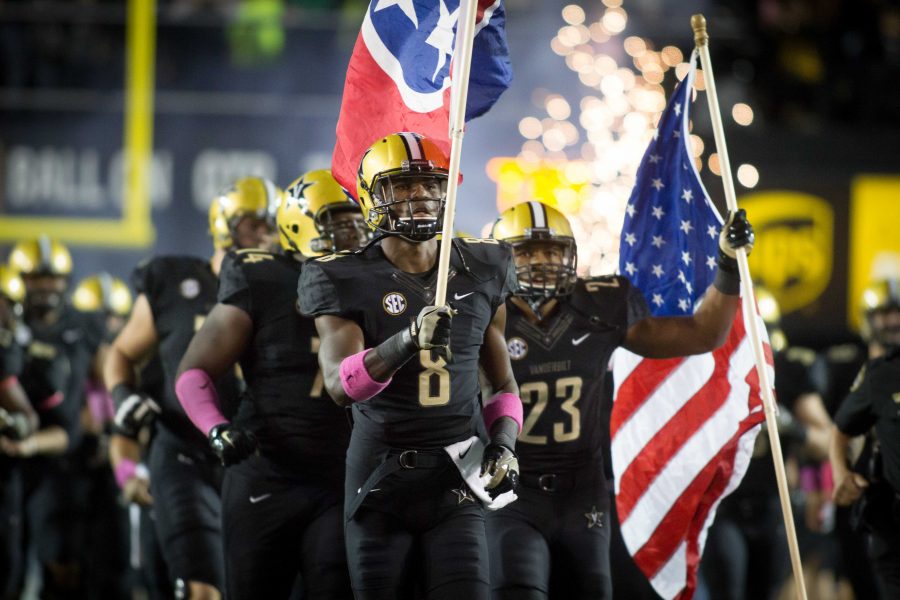Leading up to the 2016 football season, some experts and pundits picked Vanderbilt to make it to a bowl game for the first time since James Franklin brought the Commodores to three straight bowl games from 2011 to 2014.
After a 2-4 start to the season, that idea was put on hold for a bit. However, the Commodores have won two games in a row for the first time in the Derek Mason era with wins over Georgia and Tennessee State. At 4-4 with four games remaining on the schedule, the door is open for the Commodores to sneak into a bowl game.
So, how could they do it?
The conventional way would be to win two of their last four games of the season to give them six wins, making them bowl eligible. However, that task is tougher than it seems, as two of their final four opponents are ranked (Auburn and Tennessee) and another was just dropped from the rankings this past week (Ole Miss). That leaves their game on Nov. 12 at Mizzou as the most “winnable” game left. Getting to 5-7 won’t be enough to make them bowl eligible.
That might, not matter, though.
Last season, the NCAA ran into a conundrum when only 79 teams were bowl eligible at the end of the regular season to fill 82 bowl game slots. In response, the NCAA allowed three teams with losing records to play in bowl games (Minnesota, Nebraska and San Jose State) based on Academic Performance Rate (APR), a metric implemented in 2003 to keep schools accountable for the academic performance of their student-athletes. They also placed a three-year moratorium on new bowl games, freezing the amount of bowls at 41 again for the 2016 season, including the playoff National Championship game.
That situation could manifest itself again this season, and if Vanderbilt can get to five wins, that might be enough to put them in a bowl game. Let’s crunch the numbers.
Right now, there are 20 teams in the FBS with six or more wins, and therefore already bowl eligible. There are 31 teams with five wins, and it is fairly safe to assume that basically all of them will get one win in the final five weeks of the season (for the sake of our calculations, we will assume they all do).
There are 27 teams with four wins, including the Commodores. Let’s assume for our calculations that 22 of them make it to six wins, not including Vanderbilt.
There are countless other three-win teams, but it’s safe to assume most of them won’t make it to six wins, if they aren’t good enough to win more than three games through the first eight weeks. For the sake of accounting for all possible scenarios, let’s say two three-win teams make it to six wins.
The NCAA needs 80 teams to play in the 40 bowl games this season (the 41st game is the title game, and those teams are already included in the initial 80), and if those numbers above hold true, that means there will only be 75 bowl-eligible teams to fill those slots. Even if all of the four-win teams, not including Vanderbilt, get to six wins, there will still be a shortage of bowl-eligible teams.
If that situation plays out, the NCAA will likely have to fill the remaining slots with five-win teams. They do so using the APR, selecting the five-win teams with the highest APRs. As you can safely assume, Vanderbilt performs very well in APR. Here are the top APR schools in the 2014-15 academic year, the most recent year with up-to-date information:
[table id=1 /]
You can check out the APR rankings for any sport and any conference here.
As you can see, Vanderbilt ranks 11th in APR in the entire NCAA when it comes to football. That means that Vanderbilt football players perform exceptionally well in the classroom, which is to be expected at a top-15 academic institution. That will give them a huge leg-up in making it to a bowl game with five wins.
In fact, they may be the first or second choice among 5-7 teams, should they get there. Four of the teams ahed of the Commodores are in the Ivy League, which doesn’t send teams to bowl games. Two of the teams are also in the FCS, so they won’t be in any bowl games. Wisconsin and Minnesota are at five wins, so they’ll likely get to six and automatically make a bowl game.
That leaves Duke and Northwestern as the remaining threats to Vanderbilt making a bowl game at 5-7. Northwestern is at four wins, on a three-game winning streak, and have three out of their five remaining games against unranked opponents, so it’s highly likely they get to six wins too. Duke is at three wins and has to play two more ranked teams, as well as three tough road games, so they could also go 5-7, but could also fall short of that.
Even if Duke also goes 5-7, most mathematical scenarios call for at least two bowl slots to be filled by 5-7 teams, so Vanderbilt would still be in, even with a 5-7 Blue Devils team.
In conclusion, Vanderbilt has a very strong chance of making a bowl game even if they don’t make it to six wins. There is likely to be a shortage of six-win teams, and based on the APR rankings, Vanderbilt is a top choice to be selected to a bowl at 5-7.
Of course, there’s also a discussion of whether or not making a bowl at 5-7 “counts.”
But, that’s for another day, or another column.












